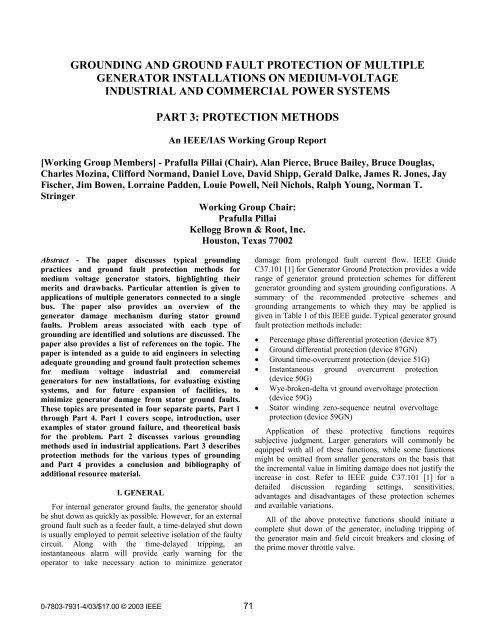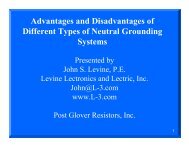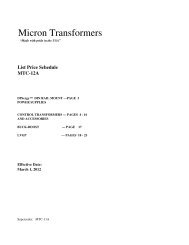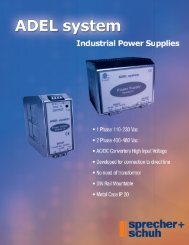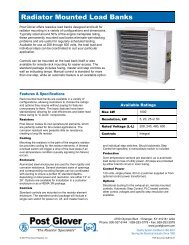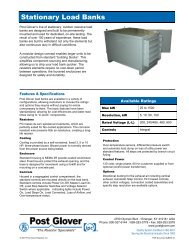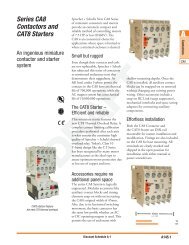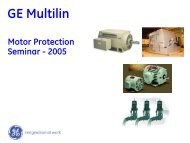IEEE Hybrid Grounding
IEEE Hybrid Grounding
IEEE Hybrid Grounding
Create successful ePaper yourself
Turn your PDF publications into a flip-book with our unique Google optimized e-Paper software.
GROUNDING AND GROUND FAULT PROTECTION OF MULTIPLE<br />
GENERATOR INSTALLATIONS ON MEDIUM-VOLTAGE<br />
INDUSTRIAL AND COMMERCIAL POWER SYSTEMS<br />
PART 3: PROTECTION METHODS<br />
An <strong>IEEE</strong>/IAS Working Group Report<br />
[Working Group Members] - Prafulla Pillai (Chair), Alan Pierce, Bruce Bailey, Bruce Douglas,<br />
Charles Mozina, Clifford Normand, Daniel Love, David Shipp, Gerald Dalke, James R. Jones, Jay<br />
Fischer, Jim Bowen, Lorraine Padden, Louie Powell, Neil Nichols, Ralph Young, Norman T.<br />
Stringer<br />
Working Group Chair:<br />
Prafulla Pillai<br />
Kellogg Brown & Root, Inc.<br />
Houston, Texas 77002<br />
Abstract - The paper discusses typical grounding<br />
practices and ground fault protection methods for<br />
medium voltage generator stators, highlighting their<br />
merits and drawbacks. Particular attention is given to<br />
applications of multiple generators connected to a single<br />
bus. The paper also provides an overview of the<br />
generator damage mechanism during stator ground<br />
faults. Problem areas associated with each type of<br />
grounding are identified and solutions are discussed. The<br />
paper also provides a list of references on the topic. The<br />
paper is intended as a guide to aid engineers in selecting<br />
adequate grounding and ground fault protection schemes<br />
for medium voltage industrial and commercial<br />
generators for new installations, for evaluating existing<br />
systems, and for future expansion of facilities, to<br />
minimize generator damage from stator ground faults.<br />
These topics are presented in four separate parts, Part 1<br />
through Part 4. Part 1 covers scope, introduction, user<br />
examples of stator ground failure, and theoretical basis<br />
for the problem. Part 2 discusses various grounding<br />
methods used in industrial applications. Part 3 describes<br />
protection methods for the various types of grounding<br />
and Part 4 provides a conclusion and bibliography of<br />
additional resource material.<br />
I. GENERAL<br />
For internal generator ground faults, the generator should<br />
be shut down as quickly as possible. However, for an external<br />
ground fault such as a feeder fault, a time-delayed shut down<br />
is usually employed to permit selective isolation of the faulty<br />
circuit. Along with the time-delayed tripping, an<br />
instantaneous alarm will provide early warning for the<br />
operator to take necessary action to minimize generator<br />
damage from prolonged fault current flow. <strong>IEEE</strong> Guide<br />
C37.101 [1] for Generator Ground Protection provides a wide<br />
range of generator ground protection schemes for different<br />
generator grounding and system grounding configurations. A<br />
summary of the recommended protective schemes and<br />
grounding arrangements to which they may be applied is<br />
given in Table 1 of this <strong>IEEE</strong> guide. Typical generator ground<br />
fault protection methods include:<br />
Percentage phase differential protection (device 87)<br />
Ground differential protection (device 87GN)<br />
Ground time-overcurrent protection (device 51G)<br />
Instantaneous ground overcurrent protection<br />
(device 50G)<br />
Wye-broken-delta vt ground overvoltage protection<br />
(device 59G)<br />
Stator winding zero-sequence neutral overvoltage<br />
protection (device 59GN)<br />
Application of these protective functions requires<br />
subjective judgment. Larger generators will commonly be<br />
equipped with all of these functions, while some functions<br />
might be omitted from smaller generators on the basis that<br />
the incremental value in limiting damage does not justify the<br />
increase in cost. Refer to <strong>IEEE</strong> guide C37.101 [1] for a<br />
detailed discussion regarding settings, sensitivities,<br />
advantages and disadvantages of these protection schemes<br />
and available variations.<br />
All of the above protective functions should initiate a<br />
complete shut down of the generator, including tripping of<br />
the generator main and field circuit breakers and closing of<br />
the prime mover throttle valve.<br />
0-7803-7931-4/03/$17.00 © 2003 <strong>IEEE</strong> 71


